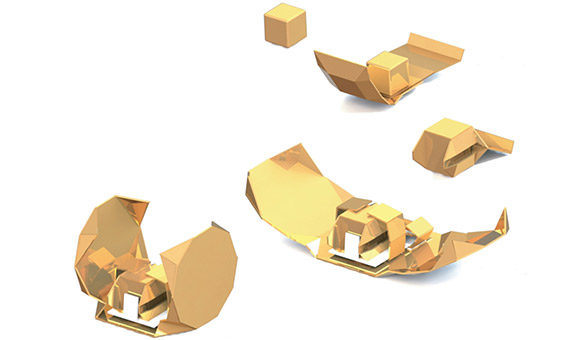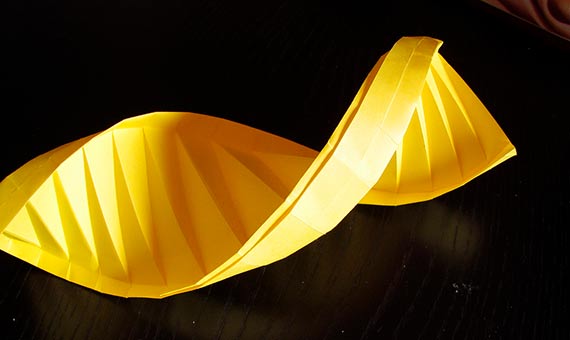Virtually any 3D structure can be reproduced with a folio. Scientists and engineers from around the world study the secrets of origami to apply that versatility to their areas of study. The ability of a material to bend and recover its shape is useful in fields such as biomedicine or the aerospace industry.
In addition, the technique can be applied to structures of any size, from nanorobots to the large solar panels of space satellites. The art of giving capricious shapes to paper has many more applications than the purely decorative. These are the 1001 faces of origami.
Protein nanocages
The main premise of this Japanese technique is to create figures with a sheet of paper without the help of scissors or glue. The origin of the word makes it clear: “ori” (fold) and “kami” (paper). An international team of researchers has followed this idea to create protein nanocages with biomedical applications.
As Roman Jerala, director of the Department of Synthetic Biology and Immunology at the National Chemistry Institute of Slovenia and lead author of the work, explains to OpenMind, their technology folds the polypeptide chain —a chain of one type of molecule, the peptides— into tiny cages with polyhedron shapes.

“The final shape is defined by the order of modules that self-assemble into the correct shape,” says the biochemist. The scientists, whose work is published in the journal Nature Biotechnology, designed tetrahedra, rectangular pyramids and triangular prisms between five and ten nanometres in diameter. The cages were self-assembled correctly in bacteria, mammalian cells and live mice, without causing unwanted side effects.
The authors see a wide range of biomedical applications for these mini structures. “From the encapsulation of enzymes or drugs, targeted delivery and release of cargo molecules, designed vaccines and likely also molecular machines,” summarizes Jerala. The next step will be to create figures that open and close in response to external stimuli such as light or pH.
Robotic metamorphosis
The mini-robots designed by Shuhei Miyashita and his team are, in fact, activated by an external stimulus: heat. As published in the journal Science, they have managed to turn a small magnetic cube into a robot that walks, rolls, floats and slides.
Miyashita, a researcher at the Intelligent Systems and Nano-science Research Group at the University of York (United Kingdom) and in charge of the research paper, tells OpenMind that: “Origami offers a rich potential to convert a 2D shape to a 3D one.” The small cube is moved across a magnetic surface until it is positioned on a sheet of self-folding origami, which, upon being activated by heat, envelops the cube like an exoskeleton. More origami layers can be added and the cube can continue being moved. When submerged in water, the origami exoskeletons either detach themselves or float.
The origami sheets are made of metallized polyester, although in another work the researchers used the intestinal wall from a pig so that it was biodegradable. One of its applications focuses on the surgical field. “We are developing origami surgical robots that can be ingested, change the capabilities as shown in the paper, and eventually degrade (digested),” says Miyashita. Another use would be in rescue operations; robots could get to the victim and adopt the necessary shape to provide assistance in cases that human emergency services cannot reach.
Origami in space
In general, the technique of origami is limited to folding thin sheets of paper. But what happens if we want to work with much thicker materials? This is what interests Zhong You, Professor of Engineering Sciences at the University of Oxford (United Kingdom), who has devised an innovative engineering method so that thick panels can be folded.

“The advantage is that the thick sheet will follow the route of the origami folding process designed for the thin sheets,” explains You to OpenMind, whose article is published in the journal Science. With other methods, the sheet becomes too flexible, bending into other shapes not desired by the designer.
Two examples of coarse materials in which this new technique could be used are solar panels and the reflecting surfaces of satellite antennas sent into space. To limit the movements of the material, researchers have used mechanical links of four, five and six vertices. With these, they have achieved 3D joints that reproduce the linear movement seen in origami models.
Useful for the cellular universe
Observing the biological processes that take place within cells is not an easy task. With the help of fluorescent molecules, a team of scientists developed super-resolution microscopy a couple of decades ago, which allows us to enter the cellular universe with unprecedented detail.

The technique won the 2014 Nobel Prize for Chemistry for its discoverers and today scientists from all over the world use it in their laboratories. To improve the accuracy of the technology, an international team of researchers has designed an origami of DNA with a structure of twelve helices combined with GFP antibodies (a green fluorescent protein).
As revealed in the study, published in the journal Nature Methods, the technology is used to quantify the number of copies of proteins in cellular environments using super-resolution microscopy. The authors expect their method to become widespread as a standard calibration system.
Laura Chaparro
Comments on this publication